
How Long Can You Live on Dialysis?
When kidneys stop functioning, you may need a kidney transplant or dialysis. The latter filters your blood by removing toxins and waste substances, thus imitating the function of your kidneys. You may need to undergo several dialysis sessions every week. It can be done at home or a dialysis center in Navi Mumbai. The question is, how long can a person survive on dialysis? What is the average life expectancy for these patients? And what can you do to improve your quality of life? Let’s find out.
Factors Affecting Life Expectancy on Dialysis
a) Age and Overall Health:
Younger people on dialysis have a higher life expectancy rate than elders. Existing medical conditions like chronic disease might also affect life expectancy.
b) Type of Dialysis Treatment:
The type of dialysis treatment you undergo affects your survival rate and quality of life. People on peritoneal dialysis are likely to survive longer than those on hemodialysis.
c) Lifestyle Changes:
It’s essential to maintain a healthy lifestyle through a kidney-friendly diet. Avoid processed foods, items high in salt and sugar, and any substances that may impair your kidney function. Adhering to your treatment plan is another critical aspect. Delaying or missing dialysis sessions can shorten your lifespan.
Average Life Expectancy on Dialysis
The average mortality rate for those undergoing hemodialysis is 15-20 percent, with a 5-year survival rate of less than 50 percent. Life expectancy increases dramatically by up to 80% for those who consider a kidney transplant.
The life expectancy for people on dialysis depends on several factors. On average, it’s 5-10 years, but some people live healthy and fulfilling lives for 20 years and longer. People with an existing medical condition, such as heart disease, diabetes, or other chronic conditions, may have shorter lifespans.
Also Read: How Do Dialysis Patients Die?
Improving Quality of Life on Dialysis
Being on dialysis can be tough on your mental and physical health. Here’s what may help improve your quality of life.
i) Adhere to the Schedule:
A nephrologist in Navi Mumbai will explain the number of sessions you need every week, how long each session lasts, and other factors. Missing dialysis can cause complications and affect your life expectancy, so stick to the pre-determined schedule.
ii) Eat Right:
Your kidneys’ health is largely affected by your dietary choices. Kidney-friendly food, which is low in potassium, salt, and sugar, is your best bet. Drink enough water to keep yourself hydrated.
iii) Be Physically Active:
Consider yoga, stretching, and light physical exercises to stay active, boost your blood circulation, and uplift your mood.
iv) Take Your Prescribed Medication:
If you have high blood pressure, diabetes, or other medical issues, your doctor will recommend medication to keep them in check. Make sure you never miss a dose.
v) Consider a Long-term Solution:
If you want to improve your survival rates, a kidney transplant is the most practical and effective treatment option. Although it’s an invasive surgical procedure that comes with certain risks and a lengthy recovery period, a transplant is the only way to get rid of the diseased kidneys and live with healthy, functioning ones.
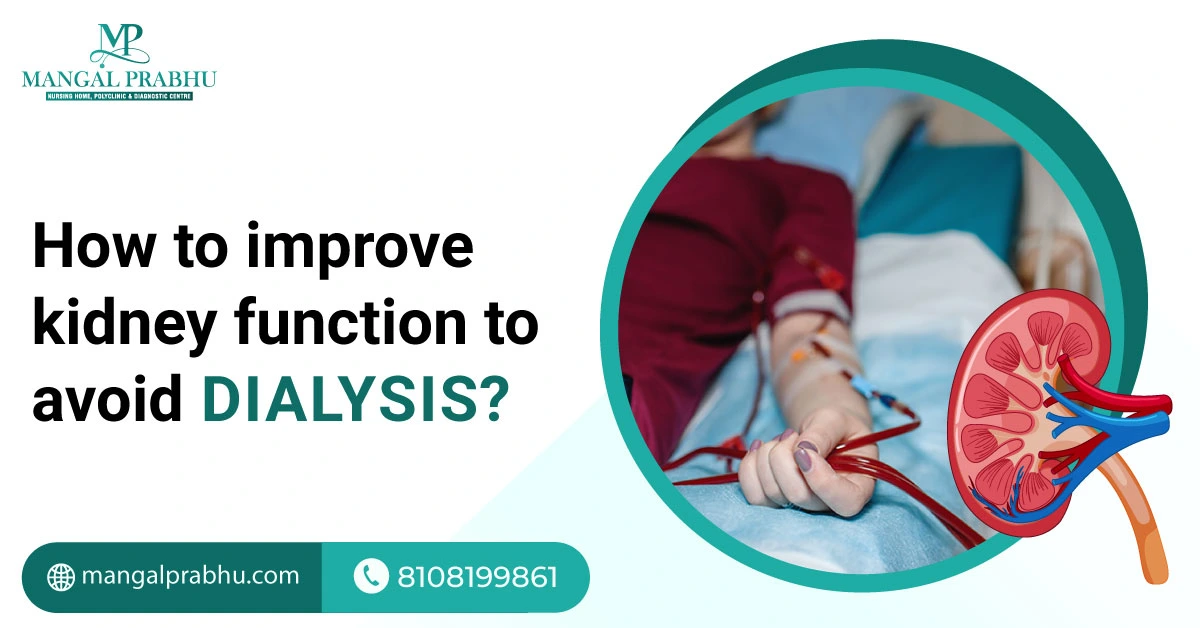
How To Improve Kidney Function to Avoid Dialysis?
Dialysis is a life-saving treatment for patients who are at an advanced stage of kidney disease. While it may be necessary for those who’ve sustained severe kidney damage, there are ways you can avoid going through dialysis. We’ve compiled a list of the best kidney practices recommended by every nephrologist in Navi Mumbai for good kidney health. These can help improve kidney function, making it more efficient at filtering the waste and excess fluid from your bloodstream. Here’s what can help.
Diet and Nutrition
Your diet plays an important role in keeping your kidneys healthy. You should follow a balanced diet with low sodium, moderate amounts of lean proteins, low-potassium and low-phosphorus foods. Try to include more vegetables, fruits, and low-fat products in your diet to protect your kidneys. You can also consult a registered dietician to create a customized, kidney-friendly diet plan for you.
Hydration
Drink plenty of water to flush out toxins from your body. Hydration dissolves minerals and waste products in your bloodstream, including creatinine and urea. Moreover, the risk of kidney stones increases drastically when you are dehydrated. This leads to highly concentrated urine, which can form mineral deposits that turn into kidney stones. That said, you must not drink too much water, as it can cause water intoxication. Ideally, 6-8 glasses of water are sufficient, but always consult your doctor if you have advanced-stage kidney disease.
Lifestyle Changes
1) Exercise:
Incorporating exercise into your routine can significantly impact your lifestyle and reduce your risk of developing chronic diseases. You don’t have to join a gym or practice high-intensity workouts. Just taking a walk every day, doing household chores, and trying aerobic exercises will do.
2) Avoid Stress:
Managing stress is another vital part of reducing your risk of developing chronic kidney disease. Stress is linked to heightened blood pressure, which can narrow the arteries in the kidneys, affecting their ability to filter out waste effectively. Chronic blood pressure can cause kidney disease. Practice meditation, yoga, and other exercises to manage stress. Consult a professional counselor to discuss the best stress management techniques.
3) Regulate Your Blood Sugar Level:
People with diabetes are also more likely to develop kidney diseases compared to those with regulated sugar levels. Like blood pressure, high blood sugar levels can damage the blood vessels in your kidneys, impairing their function. Monitor your blood sugar regularly and take your prescribed medication, including insulin shots, if prescribed.
Monitoring and Medical Check-ups
Schedule regular health checkups if you have a family history of kidney diseases, high blood sugar, high blood pressure, and other conditions that make you more prone to developing kidney issues. Blood and urine tests can help identify unhealthy kidneys early on. Remember, the sooner it’s diagnosed, the better the chances you won’t need to visit a dialysis center in Navi Mumbai. Seek immediate medical care if you experience reduced urine output, fatigue, nausea, loss of appetite, and shortness of breath. These are some warning signs of severe kidney disease.
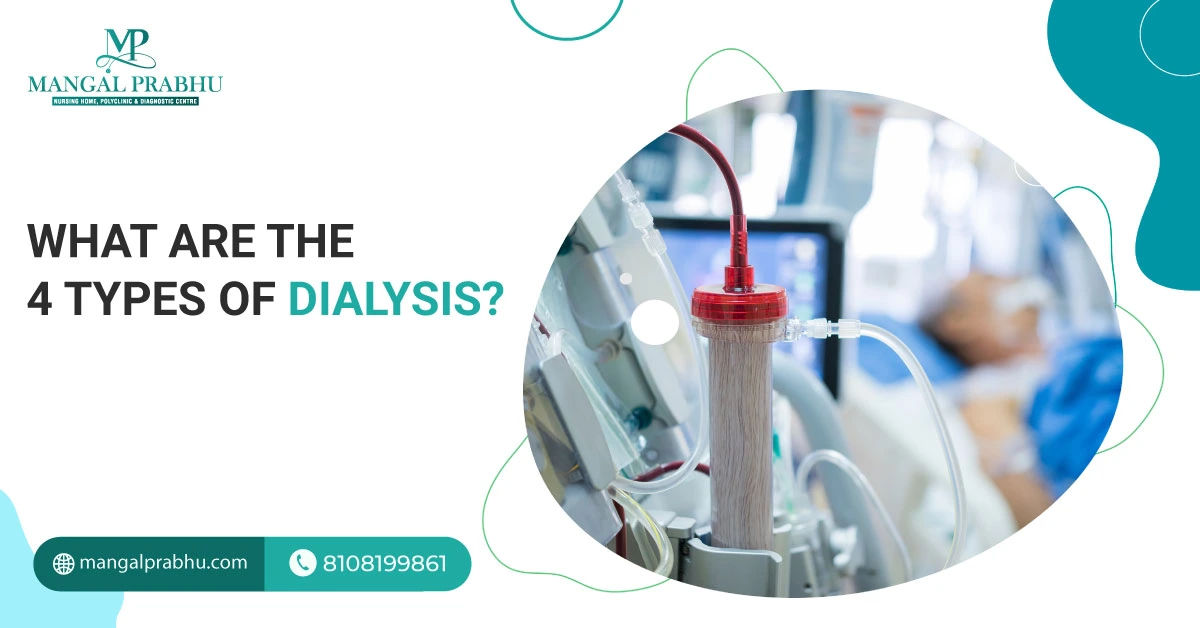
What are the 4 Types of Dialysis?
When your kidneys’ function drops to 10-15 percent, you will be put on dialysis to prevent the accumulation of waste products in your blood. Dialysis imitates the function of your kidneys by filtering excess salt and waste from your blood. Dialysis centers in Navi Mumbai can execute the procedure in four different ways.
If you are wondering what are the 4 types of dialysis, read on.
1) Hemodialysis
Hemodialysis involves a dialyzer, often referred to as an artificial kidney. A machine removes the blood from your body, purifies it through the dialyzer, and transfers the filtered blood back to your body. The procedure lasts between 3 and 5 hours and is needed thrice a week. AV fistula or AV graft can be used to access your blood vessels. Sometimes, the catheter is placed on your neck or chest for quick access.
Pros
- It’s done under medical supervision and is a safe procedure
- Removes all kinds of toxins from your blood efficiently
Cons
- Multiple visits to the dialysis center
- Time-consuming
- Side effects include nausea and dizziness due to low blood pressure
2) Peritoneal Dialysis
If you want flexible dialysis that can be done at home, work, or while you’re asleep, peritoneal dialysis is your safest bet. The kidney dialysis treatment doctor in Navi Mumbai performs a small surgery to insert a catheter into your abdomen, through which dialysate (a special solution) flows into your belly. The peritoneum acts as the natural filter. It collects all toxins from your bloodstream into the solution, which is then drained out.
It’s categorized into two types:
- Continuous Ambulatory Peritoneal Dialysis (CAPD): It’s needed 4-5 times a day while you are awake. Each session takes 30-40 minutes.
- Automated Peritoneal Dialysis (APD): As the name suggests, the dialysis is executed automatically, mostly overnight.
Although it’s the best choice for those who can’t visit the hospital for dialysis frequently or spend 3-4 hours in each session, peritoneal dialysis requires proper incision care. The common risks include infection (peritonitis), weakened abdominal muscles, and hernia.
3) Continuous Renal Replacement Therapy (CRRT)
CRRT is reserved for patients diagnosed with acute kidney failure and those who are monitored in the Intensive Care Unit. Unlike typical dialysis procedures, which last 3-4 hours, this one runs slowly and filters the waste from your bloodstream in a 24-hour cycle. It mimics your kidney function, puts less strain on your heart, and stabilizes your blood pressure. The therapy is the safest choice for critically ill patients whose bodies cannot tolerate regular dialysis.
4) Home Hemodialysis
It’s similar to regular hemodialysis, except you can do it at home. The machine filters your blood and returns the purified blood to your body. The best part about home hemodialysis is that it offers flexibility in running the dialysis machine. You can choose the normal or shorter session that lasts 2-3 hours but is required 5-6 days a week. Nocturnal HHD is another great choice for patients who want a gentle treatment that lasts 5-6 hours and can be executed overnight.

Side Effects of Dialysis in the Elderly
End-stage kidney disease requires either dialysis or a kidney transplant. While it’s a life-saving medical procedure for kidney patients, both types of dialysis procedures come with certain risks. The odds of complications are higher in the elderly.
The nephrologist in Navi Mumbai will help you weigh the risks and benefits of dialysis and offer detailed guidelines on how to manage most side effects. If you are considering dialysis but are concerned about complications, we’ve created this post that explains possible side effects and serious complications of dialysis in the elderly.
Common Side Effects of Dialysis in the Elderly
Before we dive into the side effects of dialysis, let’s understand how dialysis works.
Dialysis replicates the kidney function in people whose kidneys have stopped functioning. The procedure filters waste and fluid from the blood. Here’s what you might experience in between your dialysis sessions.
1) Fatigue and Weakness:
Dialysis can be physically exhausting, especially for elderly people with weak immune systems. Fatigue from dialysis is mainly caused by nutritional deficiency, as the process filters essential vitamins and nutrients along with waste products. Additionally, each dialysis session is pretty lengthy and may take 3-4 hours, causing fatigue.
2) Low Blood Pressure:
Too much fluid loss during dialysis can lead to a sudden drop in your blood pressure. If your blood pressure drops, you might experience additional symptoms like nausea and dizziness after dialysis.
3) Muscle Cramps:
Rapid fluid loss can cause dehydration, leading to muscle cramps. Dialysis causes electrolyte imbalance, which can result in a sudden drop in calcium, sodium, and other mineral levels. Low blood pressure can also affect blood circulation throughout the body, causing muscle cramps.
4) Itching and Dry Skin:
Skin irritation and itching are common in dialysis. Between each session, waste products build up in the blood, causing skin issues. Some people experience itching on their legs due to restless leg syndrome. Dialysis causes dehydration, which makes the skin prone to dryness and irritation.
5) Sleep Problems:
Did you know half the patients going through dialysis develop insomnia? Your kidneys filter blood regularly. However, dialysis is performed 3-4 times a week only. During this time, the waste accumulation in your body can make you feel sick. This, in turn, disrupts your sleep cycle.
Serious Complications
Dialysis can also cause long-term complications in the elderly.
- Cardiovascular Diseases: Electrolyte imbalance and excess fluid buildup can cause cardiovascular disorders, such as hypertension and heart failure.
- Infection: The regular use of catheters can cause infection.
- Malnutrition: Dialysis deprives your body of vital nutrients by filtering them with waste products, which can cause malnutrition.
- Mental Health Issues: The procedure can be mentally challenging, making the patient likely to experience anxiety and depression.
Managing Side Effects
Most of these side effects are manageable with proper medication, physical therapy, and dietary modification. Contact a professional at a dialysis center in Navi Mumbai to discuss your options, the length of treatment, and frequency.
Dialysis doesn’t have to be a permanent treatment. You can opt for a kidney transplant (if you are a good candidate) to get permanent relief.
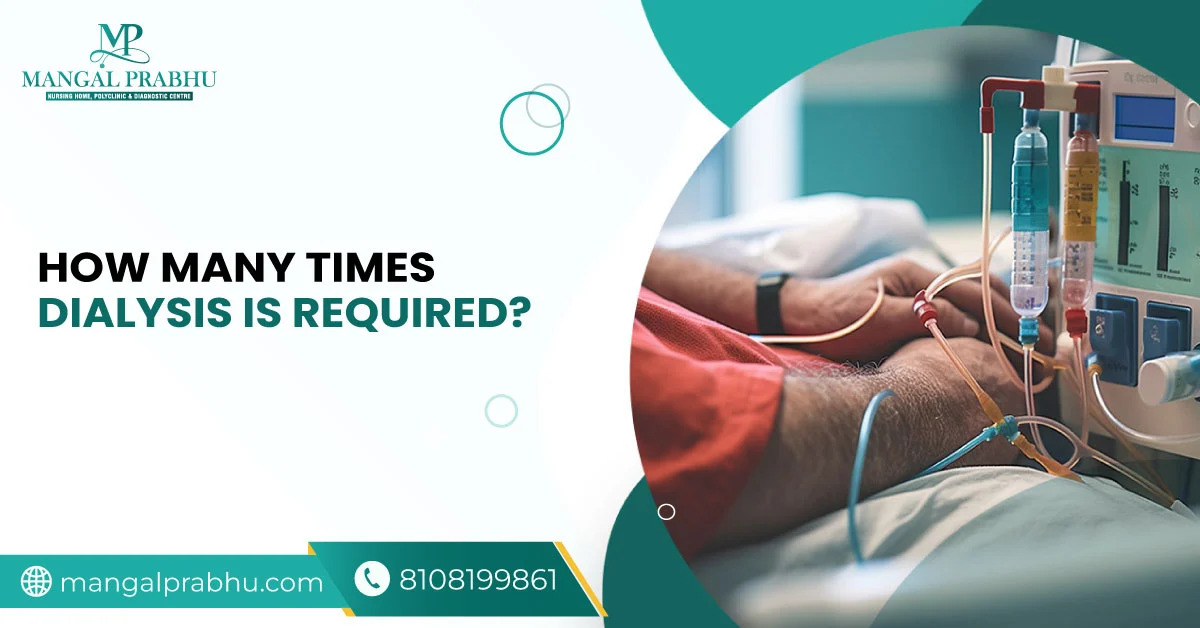
How Many Times Dialysis is Required?
Your kidneys filter blood by removing waste products and excess fluid from your body through urine. Some autoimmune diseases, diabetes, and other medical conditions can result in kidney failure. If it reaches a point where your kidneys are unable to drain excess liquid from your body, a dialysis or a kidney transplant is needed.
Dialysis performs the kidneys’ function by removing excess waste from the bloodstream. If you experience nausea, vomiting, fatigue, and swelling, visit the nearest dialysis center in Navi Mumbai and get evaluated by a nephrologist.
Factors Influencing Dialysis Frequency
Unlike kidney transplants, dialysis is not a one-time procedure. You need to schedule the treatment every week or more frequently depending on your health, the stage of kidney disease, and your doctor’s recommendation.
So, the question is, how often do you need to undergo dialysis? Let’s check out the factors that influence the frequency of this treatment.
1) Severity of the Disease:
The dialysis frequency depends on the stage of your kidney disease. If your kidney hasn’t lost its function completely, you will have fewer dialysis sessions than someone diagnosed with end-stage renal disease.
2) Type of Dialysis:
Hemodialysis is done 3-4 times weekly at a dialysis clinic. Peritoneal dialysis must be done daily.
3) Your Health:
People with diabetes, high blood pressure, and other medical illnesses that weaken their immune system might require more frequent dialysis sessions than others.
4) Doctor’s Recommendation:
Your nephrologist will assess your condition and recommend changes in the dialysis frequency based on how well your body responds to the treatment.
5) Symptoms:
If your symptoms worsen or you notice a sudden change in your health, you might have to get dialysis more frequently to manage your condition.
Standard Dialysis Schedule
Hemodialysis is the most common procedure in which blood is removed from the body and diverted to artificial kidneys, where it’s filtered and returned to the body. The procedure can last between 3 and 5 hours and is carried out 3-4 times a week, depending on your health and the severity of the disease.
You can also schedule hemodialysis five times a week and reduce the duration of each procedure to three hours. Peritoneal dialysis is done more frequently, about four times a day, and it takes up to 40 minutes per session.
Can You Change the Frequency of the Dialysis?
The frequency of kidney dialysis treatment in Navi Mumbai can be adjusted based on your health, kidney status, symptom management, and lab results (to name a few). Likewise, the frequency of the dialysis changes when you switch the type of dialysis treatment (from hemodialysis to peritoneal dialysis or vice versa).
If you are considering changing the dialysis frequency or the type, make sure you discuss it with your nephrologist first. They will offer better guidance. You must also notice your symptoms and schedule follow-up visits regularly.
Conclusion
Discuss your health and lifestyle with a nephrologist. They will guide you in choosing the best type of dialysis procedure. Home dialysis offers better flexibility. Talk to your doctor to learn more about the frequency of dialysis that will best fit your condition.

What Are the Complications of Peritoneal Dialysis?
What is Peritoneal Dialysis?
Peritoneal dialysis is a home-based treatment conducted with a dialysis machine that is placed on the umbilical walls (termed as peritoneum). Then, a doctor at Dialysis Center in Navi Mumbai transfers fluid solution known as dialysate into the abdominal cavity through a catheter, within which there are blood vessels in the peritoneum and waste products & excess fluids go from the blood vessels pass into the dialysate.
However, To ensure that this program is successful, it is essential to consider every little detail of the topic to deal with complications and achieve general patients’ well-being in the peritoneal dialysis program.
Complications of Peritoneal Dialysis
Complications which are related to the peritoneum may arise due to the patient’s state of health if the adverse conditions endanger their life and the technique used for this technique. However, complications differ from infectious to non-infectious. Infection, inefficient dialysis, and Peritonitis are some of the common hurdles in routine life which may lead to kidney failures.
Common Complications of Peritoneal Dialysis
1. Infection
Infection is very much a risk factor for patients who are on peritoneal dialysis. The catheter entry site and the lower abdomen (peritoneal cavity) can be the sites of infection. Symptoms that may be redness, swelling, pain, and drainage around the catheter site, as well as general malaise and fever, are usually associated with a lot of infections. Immediate administration of antimicrobials is a critical first step in the management of the illness.
2. In adequacy
Incomplete dialysis occurs when the dialysis process does not sufficiently clean the body of bad substances and excess liquid. The result can lead to swelling, increases in blood pressure, and an imbalance in the electrolytes. Adjusting the dialysis regime or changing to a different type of dialysis can be helpful in eliminating inadequacy.
3. Peritonitis
Peritonitis, an orchestration of inflammation within the peritoneum, emerges as a dramatic crescendo in this symphony of challenges. Symptoms like abdominal pain and cloudy dialysate are some of its causes. Act promptly with antibiotics or get the best possible treatment from Mangal Prabhu Hospital to quickly eliminate the potential risk of this issue.
Preventing and Managing Complications of Peritoneal Dialysis
Complications occasionally take center stage in peritoneal dialysis, demanding attention and strategic intervention. Some of the preventing and managing tips offered by the best Multispecialty Hospital in Navi Mumbai are:
i) Proper Technique and Care
From the gentle touch of catheter care to the meticulous attention to dialysis exchanges, it becomes a brushstroke in the masterpiece of prevention. Patients become virtuosos of technique, mastering the artistry of prevention to keep complications at bay.
ii) Regular Monitoring and Follow-Up
Regular check-ins with healthcare unveil insights into dialysis adequacy and overall well-being. These appointments help to guide patients through the intricate nuances of their PD journey.
iii) Collaboration with Healthcare Team
Collaboration with healthcare transforms challenges into triumphs. Nurture open communication, share concerns, and let the healthcare team orchestrate the best care composition for you.
Conclusion
In the grand symphony of peritoneal dialysis, complications are just fleeting notes in a symphony of resilience. By arming with knowledge, honing techniques, and harmonizing with the best Mangal Prabhu Hospital healthcare allies, you can rewrite the narrative.

When is Dialysis Required?
Your kidneys are responsible for removing waste from your bloodstream and the extra fluid through urine. This bean-shaped organ also maintains the level of potassium, calcium, and other vital minerals in your body. Kidney failure can lead to the accumulation of waste and extra fluid in your bloodstream. It’s important to consult a Nephrologist in Navi Mumbai to get a dialysis—a procedure that performs the function of your kidneys. Let’s see when it’s needed.
Symptoms of Kidney Failure
Here’s what happens if one or both of your kidneys stop working.
- Nausea and vomiting
- Feeling the urge to urinate frequently
- A metallic taste in the mouth
- Lost appetite
- Edema
- Muscle cramps
- Fatigue
- Dry skin
The symptoms are worse in people with high levels of waste substances in their blood.
When is Dialysis Required?
If your kidney is unable to clear toxins from your blood or remove excess fluid from your body through urine, you might need dialysis. The procedure is mainly recommended when only 10-15 percent of your kidney function is left.
If your kidneys stop working, you will notice swelling around the ankles, nausea, vomiting, and extreme fatigue. However, it’s possible that the toxic substances build up gradually in your bloodstream without causing these symptoms. So, it’s best to talk to your doctor to know if you need dialysis treatment in Navi Mumbai.
Types of Dialysis
Dialysis is categorized into two types:
i) Hemodialysis:
This procedure involves removing toxins from your bloodstream through an artificial kidney. The blood from your body passes through this machine to eliminate waste, and the purified blood is returned to your body. The procedure takes 4-5 hours and is performed in an outpatient setting in a dialysis center.
ii) Peritoneal Dialysis:
In peritoneal dialysis, a catheter is inserted into your abdomen and used to pass the dialysis solution (which consists of a special formula that removes toxic elements from your blood) into the peritoneum. This solution removes excess fluid and waste from the blood within your body. The waste must be drained after the procedure.
Peritoneal dialysis is a more convenient option for patients who can’t schedule regular trips to the hospital, but it comes with a few complications, like infection and hernia.
Life After Dialysis
Life after dialysis isn’t different from normal life. Your healthcare provider will give you instructions on how to keep your dialysis solution and bags clean. You can travel, work, and perform all routine tasks as usual. However, if you are traveling, you may need to arrange the dialysis sessions at the local dialysis center in your destination address. Those undergoing peritoneal dialysis can carry portable dialysis machines, solutions, and drainage bags with them.
Conclusion
A person can survive with one kidney, but if both of them stop working, dialysis or a kidney transplant is necessary. Kidney failure can occur suddenly or gradually. People with diabetes, hypertension, and other kidney diseases are at an increased risk of kidney failure. If you are diagnosed with kidney failure, dialysis can help you live a healthier and normal life.
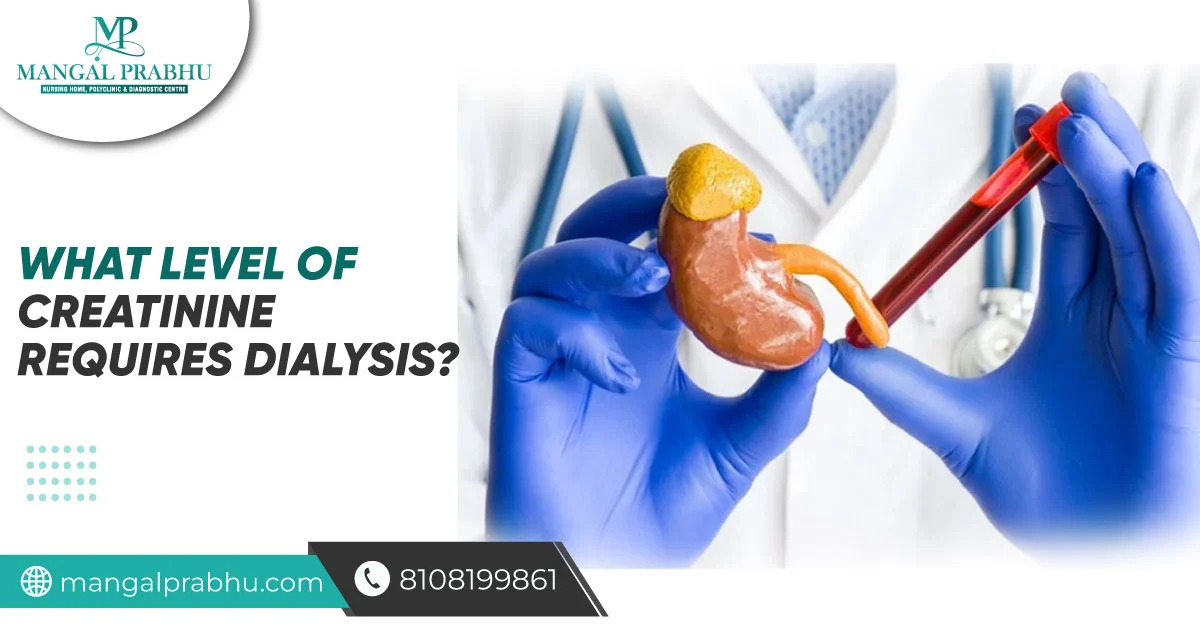
What Level Of Creatinine Requires Dialysis?
I. Introduction
Kidneys act as tireless filtration plants, eliminating these wastes, one of which is creatinine, a residue from muscle activity. However, if this filtration plant malfunctions, you end up exhausted and overwhelmed by toxins. That’s where the need for dialysis arises, a complex decision shrouded in medical jargon and uncertainty. Dialysis acts as a trusty pit crew, clearing the waste and helping an individual get back on track. Thus, it would be best for an individual to seek the best Dialysis Center in Navi Mumbai like Mangal Prabhu Hospital. However, understanding this critical crossroads and navigating the maze of creatinine help in making informed decisions.
II. Normal Range of Creatinine Levels
Understanding the creatinine level helps in making quick decisions without any hassle. However, normal creatinine levels may range from 0.7-1.3 mg/dL for women, and 0.9-1.4 mg/dL for men are guidelines, not absolutes. Think of a bodybuilder compared to a petite woman – comparing just their creatinine wouldn’t tell the whole story. Just like every individual is unique, their normal creatinine level can vary slightly depending on several factors:
- Age: Muscle mass naturally decreases with age, potentially lowering creatinine levels.
- Sex: Men tend to have more muscle mass, leading to slightly higher creatinine levels than women.
- Race: Ethnicity can influence muscle mass and slightly alter creatinine levels.
- Dehydration: Not drinking enough water and body dehydration leads to a considerable rise in creatinine levels.
- Medication: Some medications may also influence the level of creatinine.
Also Read: What is the Dialysis Process?
III. When is Dialysis Necessary?
Identifying creatinine levels helps in making the right decision for dialysis. According to the best Nephrologist in Navi Mumbai when the estimated glomerular filtration rate (eGFR) is less than 15mL/min/1.73m² an individual may require dialysis. Symptoms whisper important clues, thus when an individual experiences fatigue, nausea, and unexplained weight loss, indicates significant impairment and demands investigation. Considering crucial elements like individuals’ overall health, age, and preferences regarding treatment type and lifestyle helps in making decisions for dialysis.
IV. Other Factors to Consider
The creatinine stage acts as the starting point, but other critical factors play their roles:
- Complications like uncontrolled diabetes or heart disease can act as unexpected plot twists, potentially necessitating earlier intervention, much like unforeseen obstacles on a journey.
- Rate of decline: This refers to the speed of kidney function deterioration. Imagine a rapid leak compared to a slow drip; both require repairs but at different urgency levels.
- Patient’s voice: This is the heart of the equation. The patient’s values, desired quality of life, and active participation in decision-making are paramount. Remember, it’s their journey, and their voice matters most.
V. Conclusion
Dialysis is a powerful tool, but it’s not a magic fix. It’s a collaborative effort, like a team strategizing the best route to the finish line. A nephrologist at Mangal Prabhu Hospital is your expert guide, interpreting signs, navigating complexities, and working alongside you to craft a personalized plan. Remember, informed decisions based on a holistic approach, not just a single number, unlock the best possible outcome for your kidney health and overall journey.

What is the Dialysis Process?
Those with failed kidneys can either get a kidney transplant or consider dialysis. The latter is an ongoing procedure, which does the work of your kidneys by filtering waste and excess liquid from your blood. The procedure is done at a dialysis center in Navi Mumbai and is considered an effective way to eliminate waste that might otherwise accumulate in your bloodstream. Patients whose 90% of the kidneys have stopped functioning are good candidates for dialysis. Let’s see the procedure, how it works, its types, and more.
Types of Dialysis
There are three main types of dialysis and each works in different ways, although the purpose of each is the same.
Hemodialysis
In hemodialysis, an artificial kidney filters your blood and returns it to your body after removing all the waste and fluid. The procedure is done 3 times a week and is usually a 3-4 hour procedure, which can be done at home or the dialysis center. Before you start dialysis, your healthcare provider will perform a small surgery to enlarge your veins so that it’s easier to insert a catheter into the veins, as well as, improve the blood flow in and out of your body.
Peritoneal Dialysis
Peritoneal dialysis filters waste from your blood through the tiny blood vessels in your abdominal lining. A special dialysis solution, containing minerals and glucose, is used to conduct kidney dialysis. The solution stays in your peritoneum overnight and the waste is collected in the dialysis solution. It can be drained into an empty bag within 60 minutes. The procedure must, however, be performed at least 4 times a day.
Benefits of Dialysis
- The procedure maintains an adequate level of calcium, potassium, and other minerals in your body.
- It’s quite effective in treating kidney failure and can do most of the job of a healthy kidney.
- Dialysis can be done at home while traveling, and when you are asleep. It’s convenient.
Risks and Complications of Dialysis
The most common risk of dialysis is the infection in the graft, which is implanted into your abdomen in peritoneal dialysis. Patients can contract peritonitis from the catheter. There’s also a risk of skin infection due to the catheter. People who choose peritoneal dialysis report excess fatigue due to the lack of protein and other nutrients. There’s also a risk of a hernia around the abdominal area.
Life After Dialysis
Life with dialysis is pretty normal. You can travel, eat, sleep, raise families, and work as usual as long as you get the dialysis treatment as and when required. You can consider self-dialysis by getting the dialysis machine and solution at home. It can also be done when you are asleep. However, dialysis is mostly seen as a temporary solution to replace your kidney function with artificial kidneys. You might eventually need to undergo a kidney transplant to ensure normal and healthy kidney function.
That was all about kidney dialysis and its types. See a kidney dialysis specialist in Navi Mumbai to learn more about the procedure and the risk factors.
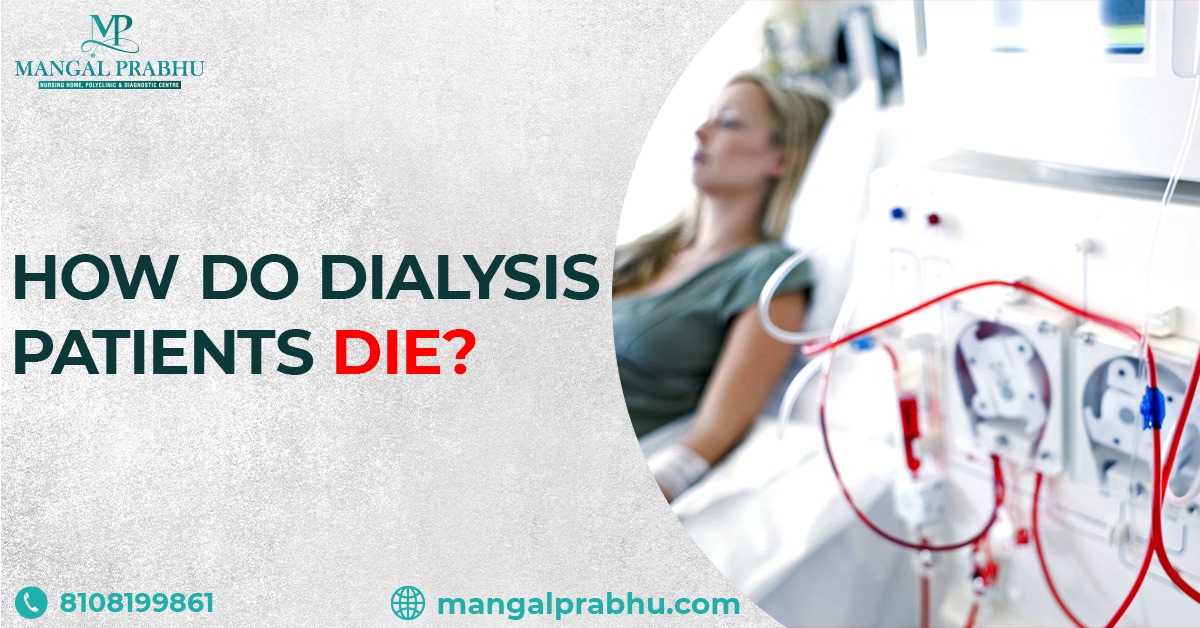
How Do Dialysis Patients Die?
Dialysis is a life-saving medical treatment for individuals with kidney failure. While it provides essential support by removing waste and excess bodily fluids, dialysis patients often face unique challenges and health risks. Here, you can explore how dialysis patients may face specific risks. Hence, understanding these risks helps you and healthcare professionals better manage and improve the care of dialysis patients.
What is Dialysis, and What Does it Do?
Dialysis is a medical procedure used to perform the critical functions of the kidneys when they can no longer do so effectively. It involves the removal of waste products and excess fluids from the blood. It helps maintain electrolyte balance and control blood pressure, ultimately prolonging kidney failure patients’ lives.
What are the Risks for Dialysis Patients?
Dialysis patients are exposed to several risks due to the chronic nature of their condition and the ongoing need for medical intervention. Some common risks include:
- Patients receiving Dialysis through a catheter or at a dialysis center are at risk of infection.
- Dialysis patients are more susceptible to heart problems.
- Chronic kidney disease often results in anemia.
- Kidney failure can disrupt the body’s balance of calcium and phosphorus.
Also Read: Preparing For Dialysis: What To Expect?
What Causes Dialysis Patients to Die?
Several factors contribute to the mortality of dialysis patients:
Cardiovascular Disease: Cardiovascular issues are a leading cause of death in dialysis patients. The strain on the heart and blood vessels due to fluid and electrolyte imbalances can result in heart attacks, strokes, and heart failure.
- Dialysis patients have weakened immune systems and are at higher risk of infections, which can become severe and life-threatening.
- Infections, if left untreated, can progress to sepsis, a severe response of the body to infection that can lead to organ failure and death.
- Complications related to dialysis access, such as infections or clotting, can lead to serious health issues.
- Dialysis patients may struggle with malnutrition due to dietary restrictions and loss of appetite, making them more susceptible to infections and other health problems.
How Can Dialysis Patients Reduce Their Risks?
At Mangal Prabhu Hospital, you can find a team of experienced Nephrologist in Navi Mumbai who provide specialized care for kidney-related conditions. Moreover, dialysis patients can take several steps to reduce their risks and improve their overall quality of life:
- Consistency in attending dialysis sessions and following prescribed treatment plans is crucial.
- Taking medications as prescribed to control blood pressure, anemia, and other complications is vital.
- Working with a registered dietitian to develop a kidney-friendly diet can help manage complications and maintain overall health.
- Proper hygiene, catheter care, and regular vaccinations can help prevent infections.
- Frequent visits to a nephrologist or healthcare provider are essential for monitoring overall health and addressing emerging issues promptly.
Conclusion
While Dialysis is a life-sustaining treatment for individuals with kidney failure, it has risks. Understanding these risks and their causes is essential for patients and healthcare professionals. At Mangal Prabhu Hospital, a trusted Dialysis Center in Navi Mumbai, experienced nephrologists work closely with patients to provide comprehensive care to improve the quality of life for dialysis patients. By adhering to treatment plans and maintaining a healthy lifestyle, dialysis patients can reduce their risks and maximize their chances of leading fulfilling lives despite their medical condition.
